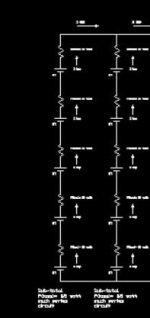zacksc
100 W
A Ligo battery is, as I understand it, a 36 volt battery made from 10 cells in series. That is, a 10 x 1. If you put four of them in parallel, then you can make essentially a 10 x 4 battery. That 10 x 4 battery which consist of 4 individual chains working together in parallel.
On the other hand, I am thinking that if you were to buy a 10 x 4 battery, that would be compromised of units of four batteries in parallel connected in a single series chain. Does that sound correct? I’d be interested in discussion of the differences in pros and cons of those two different types of architecture. I’m thinking that it makes a difference for balancing, for example.
On the other hand, I am thinking that if you were to buy a 10 x 4 battery, that would be compromised of units of four batteries in parallel connected in a single series chain. Does that sound correct? I’d be interested in discussion of the differences in pros and cons of those two different types of architecture. I’m thinking that it makes a difference for balancing, for example.






